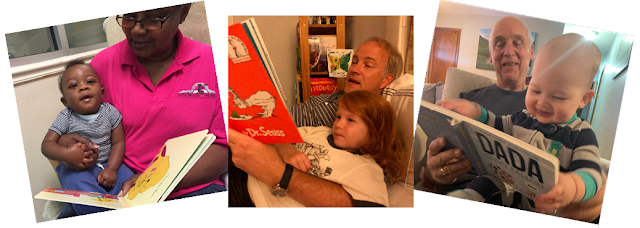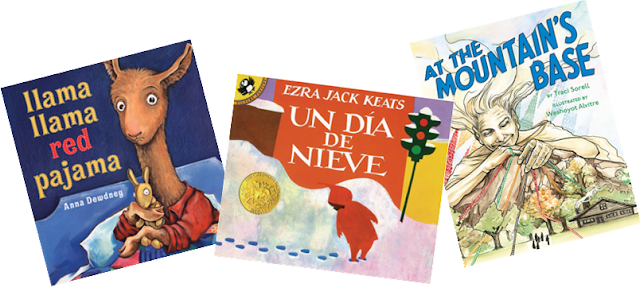“The
single most significant factor influencing a child’s early educational success
is an introduction to books and being read to at home prior to beginning
school.”
-- National Commission on
Reading --
Why it’s so important to read aloud to your child Snuggling up with a book becomes your child’s special time with you -- a pleasurable activity your child looks forward to. The more enjoyable your child finds reading, the more he will want to read. Wanting to read, or be read to, is a very important first step in learning to read. The Dolly Parton Imagination Library recommends reading aloud to your child for at least 15 minutes a day if you can.
Repeated exposure to books teaches your child the concepts of print. She learns that pages are read left to right, words are made up of letters, and punctuation marks have different purposes. She also learns about letter names and sounds, and about word families through rhyming. Reading aloud is the best way to help your child develop word mastery and grammatical understanding, which form the basis for learning how to read.
There are many genres of children’s literacy, and they promote different kinds of literacy learning. These genres include concept books (numbers, colors, alphabet…), picture books, picture story books, wordless books, nursery rhymes and other poetry. They all contribute to a better understanding of both spoken and written language.
Reading
aloud helps your child develop a “sense of story.” For example, she learns that a story has a
beginning, a middle and an end. She
learns the words we use to tell stories and when to use them. For example, we
often use “Once upon a time…” to begin a fairy tale, or “they lived happily
ever after” to end it. Those kinds of
words are not words we use when we are speaking to one another. They are words that are used only to tell
stories.
Being read to gives your child the chance to learn about people, places, and things she would not meet or see except through books. The more she knows generally, the better prepared she will be to learn to read at school. The words she comes across when reading will make sense to her because she will have heard them before during a story with you.
Reading aloud to your child is a great way to help her understand that words we use when we are speaking can be written down. In other words, that the words we speak and the words we read are the same – print is just language on paper.
Making the most of your reading time together
Discuss the cover: ask questions and talk about the cover illustrations and title.
Point to the words as you read. On occasion, point out punctuation marks and briefly explain what they mean. Use your voice to emphasize the meaning of punctuation marks, such as an exclamation mark or a question mark, or of text features such as enlarged or bold text. Your child will tend to look mostly at the illustrations, or at you. Make a point to guide his attention to the printed words. From time to time, actually point to the words as you read them. For example, “Let’s point to each word as I read it. Ready?”
Where appropriate, give the different storybook characters a unique voice. Read with expression; your voice will draw your child into the story.
As you begin to read, ask
questions to keep your child interested in the book, and to keep him
guessing as to what will happen next. With
toddlers, start
with simple questions. For example, when
reading Llama Llama Red Pajama by Anna Dewdney, ask “Where is baby llama?” Move on to more difficult questions depending
on the age of your child. For example,
when reading The Snowy Day, by
Ezra Jack Keats, to your three-year old, you could ask “Why isn’t the snowball still
in Peter’s pocket?” And your five-year
old may be ready for more challenging conversations. For example, after reading At the Mountain’s Base you could ask, “What do you think the pilot is
protecting and defending?” or “Why is her family worried about her?”
Always allow your child to “interrupt” to ask questions and make comments.
Talk about new words you come across in the story. Ask your child what he thinks the word might mean, or simply explain what the word means.
·
Talk about the story once you have finished reading it. Draw connections to your child’s life that are appropriate for his age:
- Did the story end the way you thought it would? What did you think was going to happen?
- Did you like the story? Why or why not?
- What would you have done if this had happened to you? How do you think you would have felt?
Activity ideas to do with your child after reading a book aloud
- Encourage
your child to draw a picture about a favorite part of the story. Ask her
to tell you about the picture, and write down what she says. Talk about the writing as you do it in order
for her to match her words to the print that you are creating. In this way, you are modelling for her how to
write.
- With modeling clay, help your child to make the characters and have them interact by retelling or re-enacting a favorite part.
- Print out pictures, or use magazines, catalogs, or grocery store flyers to make a collage about an idea in the story. For example, after reading Shh! Bears Sleeping, by David Martin, print or cut out pictures of bears, bluebirds, bees, berries, honey and other forest creatures and make a collage with your toddler about the bears’ activities in the story.
- Make a variation of a book with a simple idea by following the pattern of the original story but using your child’s ideas. Let her draw pictures and think of words to use in her own story. For example, after reading The Snowy Day, by Ezra Jack Keats, why not suggest making a book called The Sunny Day and let your child fill it with ideas about sunny summer day experiences like going to the park or the beach.
How much your child can do independently will depend on her age, skill level and attention span. You know your child best. However, even young children can talk and plan with you to engage in the activities. You can do as much as is necessary to support her in these activities. The goal is to encourage your child to think about the books you have read together and respond to them in creative, enjoyable ways. Most importantly – HAVE FUN!
-- Caron Bell, PhD, Early Childhood Development, and beginwithbooks.org volunteer
Note: All the books referenced in this post are November book selections from Dolly Parton’s Imagination Library and BEGIN WITH BOOKS.
Reference:
1Two Different Communication Genres and Implications for Vocabulary Development and Learning to Read, by Dominic W. Massaro, Department of Psychology, University of California, Santa Cruz, 2015









Comments
Post a Comment